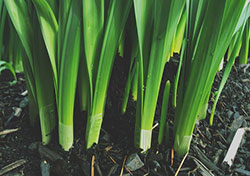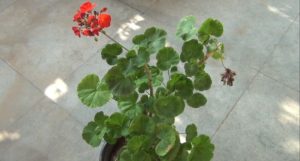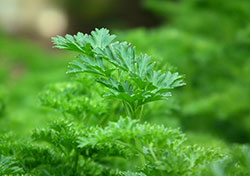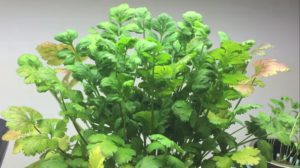Parsley is practically a superstar when it comes to Medditerenean kitchen. Its fresh and tangy flavor gives a special kick in every Western cuisine that totally makes the dish flavorful.
It also contains numerous vitamins and minerals that are necessary to keep a healthy body and mind. Did you know that consuming about 10 stalks of parsley is plenty enough to reach a human body’s recommended daily intake of Vitamin K?
Having said this, it’s best that you know how to properly harvest your parsley without actually killing your plant so you can have your required vitamins everyday fresh from your garden.
Check out the following harvesting guidelines and tips for your parsley plant as well as the growing requirements and instructions for proper storing and using so you get to abundantly harvest your parsley anytime you need to and keep them for long-term and future use.
Growing Conditions
Parsley is a biennial plant which means that it grows in its full size in the first season and blooms, seeds, and dies in the second season. However, you may opt to treat it as an annual plant, especially if you’re just mainly utilizing it for culinary purposes and have not much to do with its seeds.
Now, if you decide on keeping the plant until it blooms and seeds, you might want to equip yourself with these information that will definitely be helpful as you grow your parsley.
- Weather Conditions
Since parsley is a biennial plant, it is highly recommended to start planting or replanting the plant during the spring and let it grow for the entire summer until the winter. In places with a rather tolerable climate, parsley can actually survive frost and live through winter until it is matured enough to bloom and seed in the next spring season.
- Sun Exposure
If you are growing your parsley plant outdoors, it is best to give it a full sun exposure but it could also grow well in partial shade. But, if you choose to grow it indoors, you need to place it near the windows where sunlight can pass through. Alternatively, you can use a standard fluorescent lamp to provide an adequate supply of lights, just place the lamp 4 inches above the plant.
- Soil Requirements
Make sure that your soil is moist, loamy, and rich. To improve the quality of your soil, you may add some compost in the early growing stages of parsley or just when you’re about to start planting. For best results, you should also take note of the pH of the soil which ideally should be between 6 and 7. Alternatively, you can grow parsley in a soilless potting mix
- Watering
While parsley thrive on moist soil, it is recommended to allow the soil to be completely dried out before soaking it again with water. No need for you to worry because parsley survives in drought. Pretty amazing, isn’t it? Just remember to not overwater your plant.
- Spacing
Whether you are just starting to plant parsley from seeds or transplanting seedlings from containers directly to the ground, the ideal distance between each plant is at least 9 inches apart since a single parsley plant can grow as tall as 12 to 18 inches.
- Companion Planting
Parsley is a pretty good choice for a plant if you wish to work on companion planting. You can grow it alongside tomatoes, asparagus, onion, carrots, and corn. If you want to make your edible garden a bit more colorful and fragrant, you could also plant some roses and you’d be surprised how beneficial parsley is to this type of flower. Apparently, planting parsley near roses enhances the flower’s health and aroma.
10 Gardening Tips for the Summer That Every Gardener Should Know!
Harvest Period
In just about 70 to 90 days after planting, Parsley is all ready to be harvested. By this time, the plant should already have ample vegetation. But, of course, you can always pick its leaves all throughout the growing season. Additionally, unlike other herbs and plants, parsley can withstand even hard frost, and if properly protected can still be harvested in winter.
Another way to know when your parsley is ready to be harvested is to check on its stems. When a single stem has 3 or more clusters of leaves, it means that it is matured enough to be harvested. However, stems with only 2 or less stem segments means otherwise.
If you plan to use your parsley as an added spice to your dish, you may opt for the younger ones or those that have been harvested in its first year as they are known for their stronger flavor.
It is also best to harvest parsley before it starts flowering, otherwise it won’t taste as good.
Process Of Harvesting Parsley
Parsley is relatively one of the easiest herbs to harvest. Depending on your preferred usage, you can harvest parsley in both smaller or bulkier amounts. The former is usually preferred when parsley is intended to be used immediately as a cooking ingredient and like other herbs parsley grows more aggressively when regularly snipped.
When harvesting in smaller amounts, snip off first the outer portion of the plant and leave the inner stems to give them more time to mature. The outer portion of parsley are the older stems, so by cutting them you are preventing the plant from browning and at the same time diverting the plant’s focus of energy production on the younger stems that need further maturin which will result in a healthier and fresher produce.
You may use a sharp pair of scissors, a small knife, or you can just pick the leaves one by one using your hands since you will only be harvesting from the outside of the plant.
On the other hand, if you want to harvest parsley in a rather large amount, you will need to cut off the entire stem or bunches of parsley at the base of the plant. Use a sharp knife or a pair of scissors to cut off the base to avoid damaging the entire plant. Doing so will encourage the entire plant to grow more abundantly resulting in a bushier and healthier parsley plant.
Harvesting Tips
Harvesting regularly will give you an abundant supply of parsley for the entire harvesting season until early winter. As long as the parsley leaves are vibrant green, you can enjoy as many herbs as you would like, conversely, the flavor of the plant gradually vanishes as the color of the leaves fade and brown.
When cutting off the stalks, always do it from the bottom. Snipping the top leafy part of the plant and leaving the stems will only slow down the growth of your plant.
If you have no plans of keeping your parsley plant before the winter comes, make sure to harvest the entire plant at the end of the season, otherwise it will die out especially when left unprotected. However, if you are doing the opposite, keep your parsley indoors during the winter season but make sure to place it near the windows so it can still receive an adequate amount of sunlight.
Storing And Using
Unless you are using the parsley leaves and stalks fresh from harvest, there are two methods in storing them for future use. Whichever you choose, the first thing to do when you have finally harvested your parsley is to wash them to remove pests, dirt, or fertilizer in case you used any.
The first method is drying out the parsley. After you have washed them off, pat it dry and lay it flat on a clean cloth or platform to air dry. You could also use a food dehydrator for a quicker process.
Once it is completely dry, remove the leaves from the stems. Crumple up the dried leaves and then keep them in a clean container while you discard the stems. These dried parsley leaves can last up to a year.
Alternatively, you can just hang dry the harvested stems or bunches of leaves in a well-ventilated, dark, and warm room. In a matter of a week or two, it should be ready for storage.
The second method in storing freshly harvested parsley is by freezing it. Doing it is definitely a piece of cake. First, cut up the leaves and stalks into smaller portions. Place them in cube trays and fill these with a small amount of water, just enough to freeze the cut up leaves altogether. You can keep the parsley this way up to a year. When it’s time to use the parsley, just unfreeze the ice cubes and the herb will be ready as is.
These methods are best done especially if you plan to increase the shelf life of your parsley. Just don’t expect the stored parsley, whether dried or frozen, to be as flavorful and crisp as the fresh ones.





